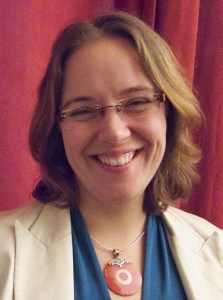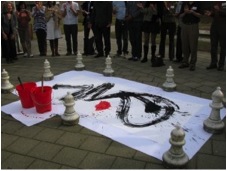Change for Good: Dynamically Steering towards a Healthy Humanity on a Healthy Planet—5 Reflections on the Authentic Leadership in Action (ALiA) Europe Conference
Anouk Brack
1. Change for Good – introduction to ALiA conference theme
2. Practice & Purpose – possible definitions
3. Experience of Embodied Leadership – getting a somatic sense of Embodied Leadership work
4. The dynamic balance of Power & Love – on the Adam Kahane and Wendy Palmer Module
5. The Art of Execution – The final brushstroke of the ALiA Europe 2011 conference
1. Change for Good
What a delight to come together and see so many people approaching their leadership as a practice, as a way of love and a way of life. Engaging in a leadership practice seems to cultivate great modesty combined with great purpose in people. We are engaging in self discovery and self development not for the sake of it but in order to serve our unique purpose better. In order to be a better instrument.
- Instrument of what?
Instrument of change.- Change towards what?
Change for good, of course.- What is “good”?
More love and wisdom manifested in the world and less suffering and ignorance.- Are we sure that’s the right way for evolution to move forward on this planet?
Yes, of course.- Can we be absolutely sure that more love and wisdom is better?
No, actually we can’t be absolutely sure. But Love acts. Love acts anyway.
2. Practice & Purpose
What’s practice?—it is an approach to activities in our life that contains a dedication, a commitment, a learning attitude and the realization that it is never done and never perfect. We just do it, and pay attention while doing it, and in the long run, it is beneficial for us and for our surroundings.
What’s purpose?—an inner calling, a push, an unfolding, our pure expression of our innate potential. When you’re on your deathbed looking back at your life, “your purpose” is the stuff you will wish you had had the courage to go for. Purpose is the acorn, given the right inner and outer conditions, becoming an oak and not a toad. You are sensing your potential inside, it resonates and it is pulling you towards living that potential. Our personal evolution towards our purpose is pushing and pulling at the same time. A push from biology to express the genetic make-up and a pull of your spirit towards the manifestation of the best you can be.
So growth has a push to it as well as a pull.
And then there’s a pulling source pulling us in, establishing a new base camp, every time we have made significant progress climbing, unfolding our potential further. Stabilizing our personality, our basecamp. Is there a pushing force? The pushing force here is directed out at the world, indicating they are not me, this is not me, it helps me set my boundaries. So interestingly both our developmental drive and our survival drive (that grows with us, hesitantly) use the pushing and pulling forces to do their job well.
3. Experience of Embodied Leadership
A prime tenet of Conscious Embodiment is that if we change the underlying energetics of the situation, then the content will change.
One way we can experience this, sitting in our chairs, is by imagining a stressful situation for 10 seconds and noticing our physiological state. Then we center using 4 part centering. Then we bring that same situation back to mind.
Try it now.
Imagine a situation that has stressed you in the past couple of days. What was happening, what did you see, what was said, how were you standing/sitting? Stop after 10 seconds.
Now, breathe down. Let your exhale be twice as long as your inhale. Hear yourself breathe.
Now imagine heat radiating off your body, equally as much behind you, off your back as your front. Left and right side and above and below.
Now relax your shoulders. Relax the back of your jaw. Relax your knees.
If you had 2% more ease in your body right now, what would that be like…..?
OK, now think of that same situation that you thought of before for 10 seconds again.
Was there a difference?
What kind of difference?
By changing our physical state we can change the situation. As we get more skillful at this we don’t react on automatic as much—we have more choices.
4. The dynamic balance of Power & Love
I attended the power and love track from Wendy Palmer and Adam Kahane. They are a wonderful combination of two powerful people being able to collaborate because of their big hearts and because they are not taking themselves so seriously. Graciously and genuinely complimenting the work of the other, both bring a very useful piece to the table for those of us trying to figure out how to best lead or facilitate change for good.
We worked with it on three levels personal, team and system level. We dove into Adam’s power and love framework looking at what a love move and what a power move look like at those different levels. We also discovered an interesting thing about love and power, it has to do with holons. So imagine several individuals in a team and several teams in an organization. Looked at on the team level the individuals are the parts and the team is the whole. Looked at on a system levels the teams are the parts and the system (eg organization) is the whole, and so on. Now, what drives a love-move is the fact that I am a part, what drives a power-move is the fact that I am a whole. My part-ness drives my love moves and my wholeness drives my power moves. Cool, huh?!
But, if I make my love moves, driven by my part-ness, from a needy place, I produce a degenerative form of love. If I make my power move, driven by my wholeness, from a disconnected place, I produce an unskilled even aggressive form of power: “Power over” instead of “power to”.
Choose a love move or a power move depending on if the next level holon, for instance the team, is too sticky (go for power move) or too fragmented (go for a love move).
While it is important to make either a power move or a love move, choosing only one at a time, it is more important to do it from a centered space. Bring the yin-yang image to mind: in the core of power we would find love and in the core of love we find power. The equivalent of that in us is when doing a love move from a centered space it communicates we are stable unto ourselves AND want to strengthen the sense of connection. Whereas imagine someone coming up to you, ellipting onto you, needing your connection in order for them to feel whole. This is a less effective way of making a love move that often backfires. In the same way when we make a power move from a centered state we communicate “we are in this together” and we are much more likely to be successful and clean in our communication. So a power move on an individual level is advocating our truth without aggression. A love move on an individual level is a posture that communicates “we are in this together” and an act of listening without taking it personally, no matter what is being said.
Interestingly, when the highly skilled leader, coming from this centered state, chooses a power move, it will almost feel like a love move. And when this same highly skilled centered leader makes a love move, it will almost feel like a power move. Don´t let that tempt you into trying to make a love move and a power move at the same time. Because for most of us less skilled in this it will either be an aggressive and messy power move or an intimidating love move. Let´s practice our modesty, remember we are just learning how to walk the leadership talk, put one foot in front of the other, alternatively using the power muscle and the love muscle. Growing the muscles in our weaker leg instead of using mainly the one that is our unconscious default solution to every problem – go on, admit it: are you more of a gluer or a fixer; more of a lover or a fighter?
The trick is to increase our awareness to the big picture. Being in a centered state is very conducive to big picture thinking. To sense what’s needed and provide that in as clean and full a way as possible. Trust the system to respond with the next step. And that’s how authentic leadership in action ends up being a deep and full dance with seemingly empty space.
5. The Art of Execution
The execution of the brushstroke distills the practice of bringing vision into action, of “joining heaven and earth.” First, we prepare the ground with care and attention. Then we connect with the space, the bigger context. We gather energy and focus, then dive in, let it flow and follow through. And finally—completion, letting go, celebration.
-Barbara Bash, ALiA artist in residence
The Final Brushstroke of ALiA Europe 2011:
http://www.aliainstitute.org/2011/03/24/the-art-of-execution/
About the Author
Anouk Brack is the Founder of Experience Integral – Cultivating Integral Leadership for Sustainability



